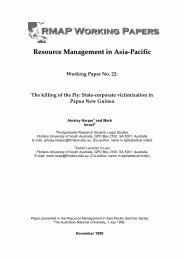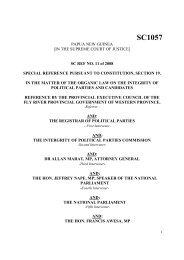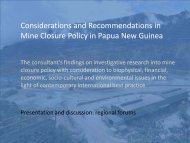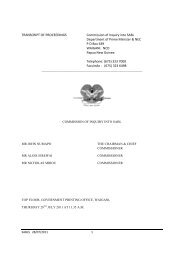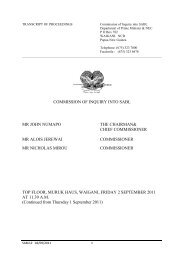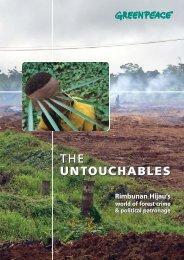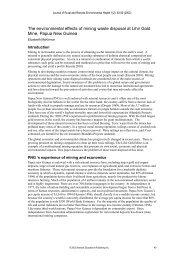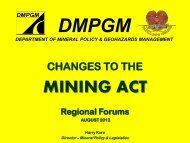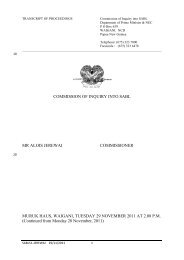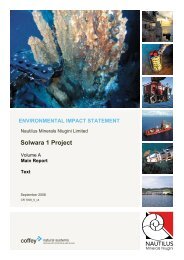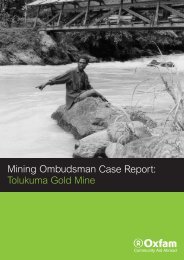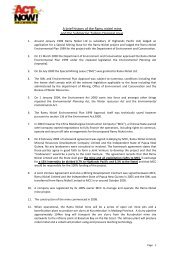Fishy business. The Social Impact of SST.pdf - Act Now!
Fishy business. The Social Impact of SST.pdf - Act Now!
Fishy business. The Social Impact of SST.pdf - Act Now!
You also want an ePaper? Increase the reach of your titles
YUMPU automatically turns print PDFs into web optimized ePapers that Google loves.
•how the tuna factory development will influence development in Wewak and the Sepik; forexample, will it require a major refocus <strong>of</strong> Provincial Government resources that will reduce theability for rural communities and other urban centres from developing?•resourcing issues, particular for local level and Provincial Government and the utilityproviders; examples include the municipal dump, which is currently totally inadequate, and willreceive extra waste from the <strong>SST</strong>C factory and associated fishing vessels; a predicted increasein prostitution with related social and health issues (particularly the spread <strong>of</strong> AIDS);•the implication <strong>of</strong> any privitisation processes for the provision <strong>of</strong> any <strong>of</strong> these services;•how an independent monitoring body and/or auditor <strong>of</strong> monitoring results might operate(including assessing whether the skills are available to do this work).<strong>The</strong> <strong>SST</strong>C says that details <strong>of</strong> the design and implementation <strong>of</strong> the social and economicmonitoring guidelines will be proved to the OEC prior to commencement <strong>of</strong> the operation(S9.3.4 p9.9). It is important that independent outside individuals and agencies conduct a fullsocial impact assessment and peer review the proposed monitoring programme, in addition tothe OEC peer review the proposed monitoring programme. It is also important that the OEC andDES provide to the reviewers the context within which the proposal and monitoring will takeplace. Given the comments above, I do not consider the social impact studies done to date (assummarised on p7.1) to be adequate. <strong>The</strong> question arising from this is who should pay for sucha study, given that it is an area <strong>of</strong> local government concern.In this regard, the following issues need clarification [emphasis added throughout]:•how much will the workers earn, and will this compensate for their removal from thesubsistence workforce? (In other words, will workers be able to purchase those things theyno longer grow/make; will their role in the family/village be adequately filled? <strong>The</strong>se arelarge scale social issues that need to be anticipated even if they are not directly theresponsibility <strong>of</strong> <strong>SST</strong>C or those wanting to work at the proposed factory);•how will the housing conditions <strong>of</strong> the workers be monitored?•how will the increase in the numbers <strong>of</strong> people coming into Wewak as a result <strong>of</strong> the proposedfactory be monitored (ie, is there a danger <strong>of</strong> creating a pool <strong>of</strong> unemployed)?•while worker health will be monitored, will there be monitoring <strong>of</strong> community health,particularly in relation to the possible spread <strong>of</strong> sexually transmitted diseases due toprostitution?•will there be any preferential treatment for the proposed factory for the delivery <strong>of</strong>water? If so, what contingencies are in place if the claimed water savings required to ensuresufficient supplies to the factory are not realised? (In other words, is the proposed plugging <strong>of</strong>water lost to ground at Moem Barracks (p4.12 and pp8.27-8.30) technically feasible?)•in addition, the proposed leak control programme by the water board requires a highfinancial and technical commitment. Has this been budgeted for?On the last two points, the <strong>SST</strong>C says that local authorities have committed to providing allassistance necessary to support the success <strong>of</strong> the tuna-processing venture. However, localgovernment is presently under-resourced (in both money and staff) and is unclear how thesecommitments are to be met.Physical Environmental <strong>Impact</strong>s<strong>The</strong> proposed EP notes that all physical environmnental monitoring programmes will havespecific plans associated with them, to be submitted to the OEC. However, until these plans aresubmitted, it is not possible to say whether the monitoring programme will be adequate. It is81



